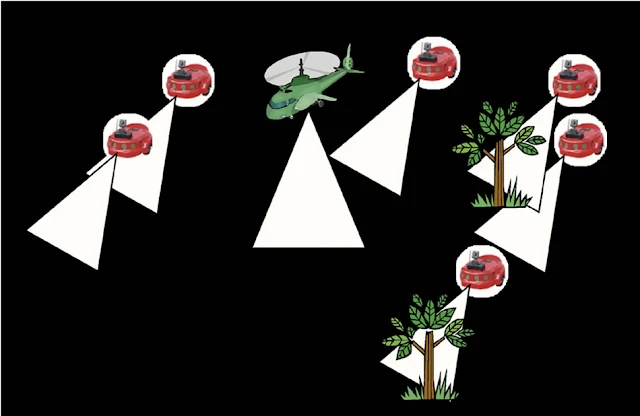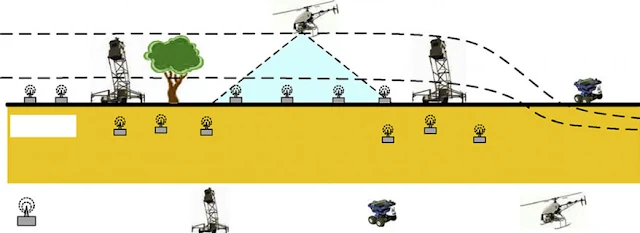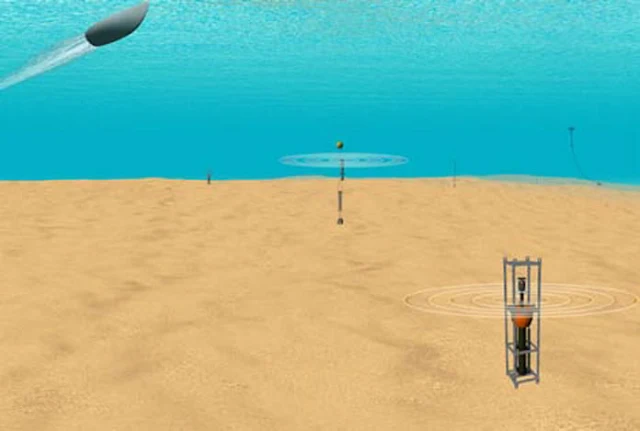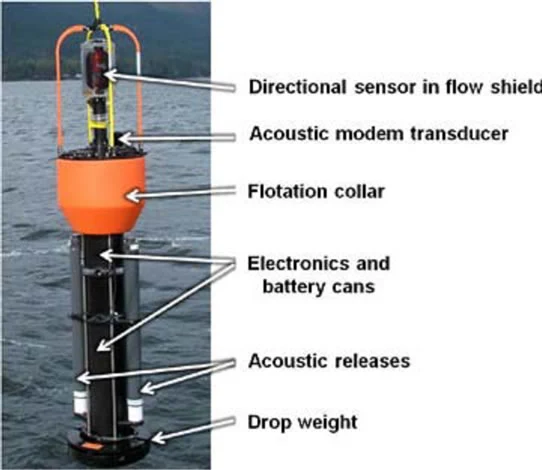WSN is an emerging wireless technology that is used in many applications for collecting information from a field of interest. Two of the promising application spans are the border surveillance and intrusion detection applications.
By Dr. Emad Felemban
Abstract:
Wireless Sensor
Network (WSN) has been emerging in the last decade as a powerful tool for
connecting physical and digital world. WSN has been used in many applications
such habitat monitoring, building monitoring, smart grid and pipeline monitoring.
In addition, few researchers have been experimenting with WSN in many
mission-critical applications such as military applications. This paper surveys
the literature for experimenting work done in border surveillance and intrusion
detection using the technology of WSN. The potential benefits of using WSN in
border surveillance are huge; however, up to our knowledge very few attempts of
solving many critical issues about this application could be found in the
literature.
Image Attribute: ELBIT SAND - Smart All-Terrain Network Detectors / Download the TechDoc
Keywords:
Wireless Sensor Network; Intrusion Detection Border Surveillance; Perimeter
Surveillance; Remote Monitoring
1. Introduction
Wireless Sensor
Network (WSN) has been emerging in the last decade as a powerful tool for
connecting the physical and digital worlds. The great interest of WSN motivated
hundreds of applications in many domains, such as healthcare, emergency
responses, intelligent traffic control, and military applications. A wireless
sensor network consists of a large number of unattended tiny devices equipped
with different sensors to perform certain tasks [1,2]. They can be used in
challenging places where it is inconvenient for human to be present. The
sensors on the devices extract physical information from the environment, such
as temperature through a temperature sensor, pressure through a barometer,
noise through a microphone, and even an image through a camera or thermal
camera. The collected data then are sent over to the control command for
further processing.
There has been a
great interest to utilize WSN for military applications and especially in
border protection [3,4]. To reach its full proposed functionality, researchers
of WSN used in border protection have to solve many interesting challenges,
such as energy efficiency [5,6], communication and hardware reliability and
security issues [7]. In this paper, we will present the state-of-the-art
technology and deployment prototypes of WSN used in border surveillance and
intrusions detection through surveying the literature for the current
deployments and real-life experimentations. Also, we will list the requirements
of such mission-critical application’s common challenges and possible solutions
to overcome them. Very few attempts have been made to tackle this application,
which opens the opportunity wide to the researchers to pursue research in this
area.
The paper is
organized as follows: Section 2 gives a brief background on the concept of
wireless sensor networking and its applications. Section 3 lists the current
projects and deployments of WSN in border protection and surveillance. Section
4 lists the challenges and research opportunities of WSN in the border
surveillance field. Finally, Section 5 concludes the paper.
2. Background
One of the key
advantages of wireless sensor networks (WSN) is their ability to bridge the gap
between the physical and logical worlds, by gathering certain useful
information from the physical world and communicating that information to more
powerful logical devices that can process it. WSN will eventually eliminate the
need for human intervention in many information gathering and monitoring
applications, especially in confined or dangerous spaces.
The low-cost and
small size features of WSN will enable the deployment of hundreds of nodes in
any field of interest. Such huge density allows more dense collection of data
in spatial and temporal domains. Sensor nodes contains of three main parts: 1)
Processing unit; 2) RF transceiver; and 3) Energy source. Multiple sensor nodes
self-form themselves to form a network to exchange information and deliver data
to a common node called the sink node.
WSN has been
applied in many applications [8], such as habitat monitoring [9], Point of
Interest Building monitoring [10], pipeline monitoring [11], smart agriculture
[12], and smart electrical grid [13]. Researchers, also, have extended the
concept of land WSN into marine sensor network [14,15]. Because RF signals do not
work under water, acoustic signals are used for communication. Marine wireless
sensor networks offer an unmatched option to a wide range of different domains,
such as monitoring coral reefs, fish habitats, and oil leaks from offshore
facilities.
3. WSN in Border
Surveillance
The role of WSN
in border surveillance, as in most WSN applications, focuses on information
gathering from various types of sensors, such as seismic, camera, thermal
camera, and motion detectors. Some advanced WSN process these raw data and send
an abstracted alarm or aggregated data to the command center, which, in turn,
takes the appropriate defense action. Many researchers from different
organizations have suggested solutions for border surveillance problems. In
this section, we will survey the literature to list the projects in this
regards. A summary of all surveyed literature is provided in Table 1.
3.1. Stealth
Detection of Mobile Targets [16]
Researchers at
the University of Virginia and Carnegie-Mellon University have developed an
energy-efficient WSN system for detecting moving vehicles through a passage
line in a stealthy manner.Figure 1 shows a picture of the deployment field and
a diagram about the setup. The authors deployed 70 MICA2 sensor nodes running
Tiny OS along a 280-feet-long perimeter. The sensor nodes were equipped with a
magnetometer, as well as acoustic and photo sensors. Stealth capabilities were
achieved by minimizing RF transmission and exposure to minimal.
To achieve its
goal, the proposed system needs localization and time synchronization modules.
In this project, localization is done through simple static configuration,
assuming that the nodes’ locations are known priori. The time of all nodes is
synchronized with respect to the base station.
The key performance
measurement of the deployment is the Degree Of Aggregation (DOA) representing
the sensitivity of the system. DOA is defined as “the minimum number of reports
about an event that a leader of a group waits to receive from its group
members, before reporting the event’s location to the base station”. The DOA
could be dynamically configured for a performance evaluation. As the DOA
increases, the number of tracking reports and false alarm decreases; however,
the reporting time increases. Therefore, an optimization problem would be how
to select the optimal DOA to achieve certain latency and minimize the number of
reports and false alarms.
3.2. Evaders
Detection with the Help of WSN [17]
Researchers the
University of California at Berkeley proposed to deploy WSN to help pursuers
detect and track evaders. The concept is based on a Pursuer-Evaders Game (PEG),
wherein two teams, Pursuers and Evaders, compete. The WSN is used to locate
enemy units and direct
Table 1. A
summary of experimental setup of surveyed literature.
Figure 1. Actual
deployment in the test field and a high level diagram of the topology [16].
pursuer team
members to catch them. All game units and actions are done in a distributed
manner with no central command.
The use of a
deployed WSN greatly improved the overall performance of a PEG. Pursuers have a
relatively small detection range. They employ limited capability sensing
techniques, such as computer vision or ultrasonic sensing; however, with the
help of WSN, complete visibility of the field and communication over a long
radius becomes possible. Figure 2(a) shows the visibility capability to
pursuers in a traditional PEG, while Figure 2(b) shows the enhancements of
visibility with the usage of WSN.
The authors have
deployed a miniature test bed with 25 motes running Tiny OS and a remote
controlled car. They assumed that the nodes are time synchronized and
Figure 2. (a)
What pursuers really see a PEG;
Figure 2. (b) WSN increase visibility to pursuers.
that the location
is provided to simplify the experiments.
3.3. Line in the
Sand [18,19]
Ohio State
University researchers have deployed 90 sensor motes with metal object
detection capabilities. The objective of the project is to detect and classify
moving metallic objects, such as armed vehicles and tanks. They used a
combination of magnetometer and micro-power impulse radar sensors. The sensor
nodes self-form into a network, and once an object passes through the network,
nodes collaborate together to classify the passing object as a metallic object
or nonmetallic object. Figure 3 shows
Figure 3. An
enclosed mote used in Line in the Sand Project.
The authors
considered a surveillance scenario of breaching a perimeter or within a region.
The system should provide target detection, classification, and tracking for
moving metallic and nonmetallic objects. The concept used in this project is
the “influence field,” which can be defined as the number of sensors that hear
an object. Moreover, the proposed system tries to capture the shape of the
influence for detection, classification, and tracking.
The authors
required accurate time synchronization with no difference more than 5 ms at any
time. Nodes are synchronized with the help of periodic time values sent by a
distinguished node. Routing and localization is done by a simple algorithm
called Logical Grid Routing Protocol. For implementation, the authors used 90
MICA motes equipped with magnetic sensor nodes packaged in a sealed enclosure,
as shown in Figure 3 arranged in 1500 square feet space.
3.4. Border
Sense [20]
Researchers from
Georgia Tech, King Saud University, and University of Nebraska have proposed a
hybrid approach to achieve coherent border patrol applications. Combining
multimedia wireless sensor network, ground sensor networks with different
sensing capabilities, underground sensor networks, and mobile sensor networks,
Border Sense provides several advantages compared with the traditional WSN
border surveillance techniques mentioned above. Figure 4 shows a simplified
diagram of the suggested framework with all different sensing capabilities. New
and challenging research issues appear as a result of this hybrid architecture,
such as coordination between all nodes tracking a single object and unified
data framework for exchanging data.
3.5. Marine
Surveillance Using Underwater/ Wireless Sensor Networks
The same
application of border surveillance of ground sensor networks can be applied in
marine surveillance and marine border protection. In [15], the researchers have
demonstrated an underwater surveillance system to detect enemy watercraft by
deploying acoustic sensor nodes in shallow water as shown in Figure 5.
Some challenges
of underwater sensor networks include slow bandwidth, noisy channel, unreliable
links, and lack of energy efficiency.
In [21], the
authors proposed innovative ship intrusion detection with wireless sensor
networks near a harbor facility. The solution depends on exploiting the
V-Shaped wave generated by ship movement on the water surface. They have used
three-axis accelerometer sensors with iMote2 on buoys on the sea surface.
Figure 6 shows the real deployment.
The deployment
uses a grid topology with predefined locations. Sensor nodes were time synchronized
before deployment. Accelerometers are used to measure the movements of buoys
during waves; these readings are then elaborated to detect passing ships and
their speeds. With additional signal and computational processing, nodes can
detect the movements of ships around their deployments.
3.6. WSN and
Neural Networks for Border Protection [22]
The researchers
from New Mexico Tech [22] proposed the usage of artificial neural networks
along with WSN for border detection. The key idea of using ANN is to discover
patterns that describe an intrusion activity and train the ANN to discover
them. The proposed system uses a set of 32 MicaZ sensor nodes equipped with
microphones and light sensors collected at the base station. The nodes were
distributed along a perimeter to detect single and group intrusion.
The experimental
results show that when using both light and sound sensors, the networks were
able to detect intrusion in very limited time with higher probability.
3.7. FleGSens: A
Wireless Sensor Network for Border Surveillance [23]
Researchers in
Germany [23] developed a sensor network prototype consisting of 200 wireless
sensor nodes
Figure 4. Hybrid
combination of multimedia, ground, mobile, and underground sensors for border
patrol.
Figure 5. (a) A
simplified diagram of the underwater sensor network to detect enemy water
craft;
Figure 5. (b) A detailed diagram of an underwater acoustic sensor node;
Figure 5. (c) An
overview of the whole underwater acoustic sensor network.
called iSense,
which was equipped with Passive InfraRed (PIR) sensors covering a 500 m-long
land strip. The objective is to ensure the integrity and authenticity of
generated alarms and availability when intruders are present.
Two protocols
were developed in this work. The first one is the trespasser detection
protocol, which utilizes the PIR sensors to detect movements within the strip
space covered. To ensure accurate detection, local PIR signals are grouped and
verified before the network is flooded with the messages. The second protocol
is the node failure detection protocol, which ensures the integrity of the
sensor network, avoiding any breach in the coverage. This is done by selecting
a random number of nodes called buddies to listen to other nodes’ heartbeats.
4. Challenges,
Requirements and Research Problems
WSN has many
challenging features that should be accounted for while designing the desired
applications, such as low processing power, low memory storage, low bandwidth,
and battery life and communication reliability. These challenges are magnified
when WSN is used in mission-critical applications, such as in border
surveillance. The following subsections list and discuss the main challenges facing
the adoption of WSN in missioncritical applications, such as border
surveillance.
4.1. Energy
Efficiency
Surveillance
missions usually last for an extended period of time. Due to the criticality of
the mission, manual replenishing of batteries might not be practical or
possible. Thus, an optimized and energy-aware operation should be considered in
designing such applications, which can extend the lifetime of the sensor
devices and the network in general.
The usage of
directional antennas in wireless communication offers many advantages, such as
increasing communication range and reducing communication energy consumption.
However, the usage of directional antennas with sensor network requires a very
intelligent and complicated network stack [24].
In addition,
researchers are now heavily investigating energy harvesting with sensor nodes.
Researchers in [25] have developed a prototype of a solar-powered sensor nodes.
A big question would big how can we utilize those technologies to extend the
life of a mission-critical sensor network?
4.2. Stealthness
and Security
It is important
for a border surveillance system to have a very low probability of being
detected, which will affect the success probability of the mission. Moreover,
any transmitted and stored information should be encrypted, secured, and
protected against interception from enemy communication devices.
There is a
fundamental tradeoff between security level and energy consumption. In
addition, some techniques to increase stealthness might suggest reducing
communication energy and bandwidth.
The importance
of providing integrity and security service for the border monitoring network
has been firstly introduced in [23]. However, more research should be done to
tackle many issues, such as providing security for different topologies and
different kinds of sensor networks.
4.3. Accuracy
False alarms
will render the surveillance mission into failure. Thus, the accuracy of
detection, tracking, and classification of trespassing objects is very
important. Hence, methods of aggregate alarms and in-network processing can be
used to minimize false alarms. Moreover, as mentioned before, the integrity of
the network is very important in reducing the false alarms and increasing the
accuracy of the whole system.
4.4. Quality of
Service
Timeliness and
reliability of detecting the intrusion is another important factor of
successful surveillance missions. QoS provisioning on communication should be
applied when an intrusion alarm is issued [26]. However, some networks, especially
underwater sensor networks, cannot utilize the same quality of service
measurements and protocols due to the nature of the application.
4.5. Quality of
Coverage
Providing the
full coverage of a surveillance field is a very important aspect of the success
of the surveillance mission. Providing a full coverage while minimizing the
cost has been an active area of research in the operational research field. In
order to reduce coverage overlap between sensors, optimization methods should
be used to select the best placement of the sensor nodes in the field [27-29].
J. He and H. Shi [30] developed a distributed algorithm to optimize the
location of sensor nodes along a barrier to minimize the cost of the full
coverage. In [31], the authors examined how to reposition a mobile sensor
network efficiently within a specified region to recover a security hole and
prevent intruders from exploiting this hole. Yang and Qiao proposed a
multi-round approach to deploy sensor nodes to guarantee barrier coverage [32].
5. Conclusion
WSN is an
emerging wireless technology that is used in many applications for collecting
information from a field of interest. Two of the promising application spans
are the border surveillance and intrusion detection applications. The main advantage
of using WSN in such applications is the high spatial and temporal data
resolution results from deploying hundreds of low-cost sensor nodes along
borders. This paper presents a literature survey of current experimentation and
deployment research work done in this application area. In addition, we have
listed the technical requirements of the surveillance applications and some
challenging aspects of using WSN in mission-critical applications, such as
border surveillance. To our knowledge, there are very few experimentations and
real deployments of such applications.
About The Author:
Emad Felemban P.hd, Currently the Director of Transportation and Crowd Management Center for Research Excellence, Kingdom of Saudi Arabia. Dr. Felemban obtained his doctorate from The Ohio State University with specialization on Wireless Sensor Network. He has done his research on "Performance and Analysis of Wireless Networks and Directional Antennas". His research interest includes emerging wireless technologies liked RFID, NFC, WiMAX, WSN. He also have IT related experience in Data Center, Networking Management and IT planning.
Emad Felemban P.hd, Currently the Director of Transportation and Crowd Management Center for Research Excellence, Kingdom of Saudi Arabia. Dr. Felemban obtained his doctorate from The Ohio State University with specialization on Wireless Sensor Network. He has done his research on "Performance and Analysis of Wireless Networks and Directional Antennas". His research interest includes emerging wireless technologies liked RFID, NFC, WiMAX, WSN. He also have IT related experience in Data Center, Networking Management and IT planning.
References:
I. Akyildiz, W.
Su, et al., “A Survey on Sensor Networks,” IEEE Communications Magazine, Vol.
40, No. 8, 2002, pp. 102-114. doi:10.1109/MCOM.2002.1024422
M. Vieira, C.
Coelho, et al., “A Survey on Wireless Sensor Network Devices,” IEEE Conference
on Emerging Technologies and Factory Automation, Lisbon, 16-19 September 2003,
pp. 537-544.
H. Luo, K. Wu,
Z. Guo, et al., “Ship Detection with Wireless Sensor Networks,” IEEE
Transaction on Parallel and Distributed Systems, 2011.
B. Essendorfer,
E. Monari and H. Wanning, “An Integerated System for Border Surveillance,” IEEE
Fourth International Conference on Systems (ICONS 09), Gosier, 1-6 March 2009.
V. Thattil and
N. Vasantha. “Energy Efficient Approach to Intruder Detection in Militarily
Sensitive Border Using Wireless Sensor Networks,” IEEE Conference on
Electronics Computer Technology, 2011.
D. Yuping, H.
Chang, Z. Zou and S. Tang, “Energy Aware Routing Algorithm for WSN Applications
in Border Surveillance,” 2010 IEEE International Conference on Technologies for
Homeland Security, Wltham, 8-10 November 2010, pp. 530-535.
E. Onur, C.
Ersoy, H. Delic and L. Skaru, “Surveillance Wireless Sensor Networks:
Deployment Quality Analysis,” IEEE Network, Vol. 21, No. 6, 2007, pp.
48-53.doi:10.1109/MNET.2007.4395110
T. Arampatzis,
J. Lygeros and S. Manesis, “A Survey of Applications of Wireless Sensors and
Wireless Sensor Networks,” 13th Mediterranean Conference on Control and
Automation Limassol, Cyprus, 27-29 June 2005, pp. 889-895.
F. M. Sabri,
“Wireless Sensor Networks for Swift Bird Farms Monitoring,” International
Conference on UltraModern Telecommunications & Workshops, St. Petersburg,
12-14 October 2009.
D. Abruzzese, M.
Angelaccio, B. Buttarazzi, R. Giuliano, L. Miccoli and A. Vari, “Long Life
Monitoring of Historical Monuments via Wireless Sensors Network,” 6th
International Symposium on Wireless Communication Systems, Tuscany, 7-10
September 2009.
I. Stoianov, L.
Nachman and S. Madden, “PIPENET: A Wireless Sensor Network for Pipeline
Monitoring,” The 6th International Conference on Information Processing in
Sensor Networks (IPSN’07), Cambridge, 25-27 April 2007.
T. Wark, P.
Corke, P. Sikka, L. Klingbeil, Y. Guo, C. Crossman, P. Valencia, D. Swain and
G. Bishop-Hurley, “Transforming Agriculture through Pervasive Wireless Sensor
Networks,” IEEE Pervasive Computing, White Plains, 19-23 March 2007. doi:10.1109/MPRV.2007.47
V. Gungor, L.
Bin and G. Hancke, “Opportunities and Challenges of Wireless Sensor Networks in
Smart Grid,” IEEE Transactions on Industrial Electronics, Vol. 57, No. 10,
2010, pp. 3557-3564. doi:10.1109/TIE.2009.2039455
J. Rice, et al.,
“Maritime Surveillance in the Intracoastal Waterway Using Networked Underwater
Acoustic Sensors Integrated with a Regional Command Center,” 2010 International
Waterside Security Conference (WSS), Carrara, 3-5 November 2010, pp. 1-6.
A. Mahdy,
“Marine Wireless Sensor Networks: Challenges and Applications,” 7th
International Conference on Networking, Cancun, 13-18 April 2008, pp. 530-535.
T. He, S.
Krishnamurthy, J. A. Stankovic, T. Abdelzaher, L. Luo, R. Stoleru, T. Yan, L.
Gu, J. Hui and B. Krogh, “An Energy-Efficient Surveillance System Using
Wireless Sensor Networks,” 2nd International Conference on Mobile Systems,
Applications and Services, Boston, 6-9 June 2004.
B. Sinopoli, C.
Sharp, L. Schenato, S. Shaffert and Sh. S. Sastry, “Distributed Control Applications
Within Sensor Networks,” Proceeding of the IEEE, August 2003. http://www.cse.ohiostate.edu/siefast/nest/nest_webpage/ALineInTheSand.html
A. Arora, et
al., “A Line in the Sand: A Wireless Sensor Network for Target Detection,
Classification, and Tracking,” Journal Computer Networks, Vol. 46, No. 5, 2004.
Z. Sun, et al.,
“BorderSense: Border Patrol through Advanced Wireless Sensor Networks,” Ad Hoc
Networks, 2011, pp. 468-477.
H. Luo, et al.,
“Ship Detection with Wireless Sensor Networks,” IEEE Transactions on Parallel
and Distributed Systems, Vol. 23, No. 7, 2012, pp.
1336-1343.doi:10.1109/TPDS.2011.274
A. Mishra, K.
Sudan and H. Soliman, “Detecting Border Intrusion Using Wireless Sensor Network
and Artificial Neural Network,” IEEE DCOSS 2010, Santa Barbara, 21- 23 June
2010.
P. Rothenpieler,
D. Kruger, D. Pfisterer, S. Fischer, D. Dudek, C. Haas, A. Kuntz and M.
Zitterbart, “Flegsens: Secure Area Monitoring Using Wireless Sensor Networks,”
Proceedings of the 4th Safety and Security Systems in Europe, 2009.
E. Felemban, S.
Vural, et al., “SAMAC: A Cross-Layer Communication Protocol for Sensor Networks
with Sectored Antennas,” IEEE Transactions on Mobile Computing, Vol. 9, No. 8,
2010, pp. 1072-1088. doi:10.1109/TMC.2010.61
J. He, R. A.
Norwood, M. Fallahi and N. Peyghambarian, “Solar-Powered Ad-Hoc Wireless Sensor
Network for Border Surveillance,” SPIE Defense, Security, and Sensing, 2012.
E. Felemban, C.
Gun and E. Ekici, “MMSPEED: Multipath Multi-SPEED Protocol for QoS Guarantee of
Reliability and Timeliness in Wireless Sensor Networks,” IEEE Transactions on
Mobile Computing, Vol. 5, No. 6, 2006.
K. Kordari and
G. L. Blankenship, “Perimeter Coverage with Wireless Sensor Networks,” IEEE
Military Communications Conference, San Diego, 2008.
E. Onur, C. Ersoy,
H. Delic and L. Akarun, “Surveillance Wireless Sensor Networks: Deployment
Quality Analysis,” IEEE Network, Vol. 21, No. 6, 2007, pp.
48-53.doi:10.1109/MNET.2007.4395110
Y. T. Hou, T. C.
Lee, B. C. Jeng and C. M. Chen, “Optimal Coverage Deployment for Wireless
Sensor Networks,” The 8th International Conference on Advanced Communication
Technology, Phoenix Park, 20-22 February 2006.
J. He and H.
Shi, “Constructing Sensor Barriers with Minimum Cost in Wireless Sensor
Networks,” Journal of Parallel Distributed Computing, Vol. 72, No. 12, 2012,
pp. 1654-1663. doi:10.1016/j.jpdc.2012.07.004
B. Bhattacharya,
et al., “Optimal Movement of Mobile Sensors for Barrier Coverage of a Planar
Region,” Theoretical Computer Science, Elsevier, 2009, pp. 5515-5528.
G. Yang and D.
Qiao “Multi-Round Sensor Deployment for Guranteed Barrier Coverage,” IEEE
INFOCOM 2010.
_______________________
Publication Details:
Int'l
J. of Communications, Network and System Sciences
Vol.6 No.5(2013), Article ID:31336,9 pages DOI:10.4236/ijcns.2013.65028
This work is licensed under Creative Commons 3.0 by the Original Publisher
Vol.6 No.5(2013), Article ID:31336,9 pages DOI:10.4236/ijcns.2013.65028
This work is licensed under Creative Commons 3.0 by the Original Publisher

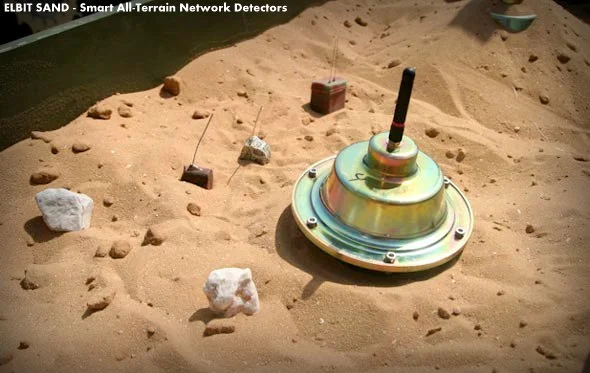

![Figure 1. Actual deployment in the test field and a high level diagram of the topology [16]. Figure 1. Actual deployment in the test field and a high level diagram of the topology [16].](https://blogger.googleusercontent.com/img/b/R29vZ2xl/AVvXsEgRL4jWQNSLY4-Nr16yVgq7xviO44Ggsf1M9DDGplq1m_XIBDknmyQYgxwHGsCJMyRIDYfInW8VPPuXyJ8fZt01M-ZG8U93rvgxOHlZhEONsXEXpMNOHELNBq_5YLkaG7EKWwz2JbLVoSg/s640-rw/FIG1.jpg)
![Figure 1. Actual deployment in the test field and a high level diagram of the topology [16]. Figure 1. Actual deployment in the test field and a high level diagram of the topology [16].](https://blogger.googleusercontent.com/img/b/R29vZ2xl/AVvXsEga-no-cUqBOXmu3-iMPITjttNGIbpRMf_EjDQTaiHmKh0OMo_etR_Nm6_Jg49hUgmdLS16YpmZGqjCQ5NqCTDs0bBtHvFPV4KEt_B3q1Dj1WXQbmLe1ksyTQwObkUmKqNl8WasMo6kX6Y/s640-rw/FIG1A.jpg)
